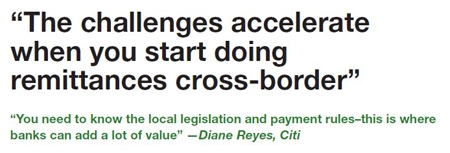BANKS MAKE A BID FOR A GROWING MARKET
By Anita Hawser
Technological innovations and the rapid acceleration of globalization are driving a sharp increase in banks’ interest in the remittances market.
We are on the cusp of something significant,” says Marcus Treacher, head of e-commerce, global transaction banking, HSBC. While HSBC processes billions of payments on its network every day, the bank has not traditionally played a major role in the global remittances space. Treacher believes that is about to change. The World Bank estimates that “global remittances totaled $420 billion in 2009, of which $317 billion went to developing countries, involving some 192 million migrants, or 3.0% of the world population.” Remittances are typically payments sent back home by migrant workers, and the World Bank says these inflows can make up a significant proportion of GDP in receiving countries.
Treacher says the aggregate cash flows and number of participants in remittances are enormous. The difficulty, he says, is that it is a fragmented market with the top 10 remittance corridors (including the US to Mexico, the Philippines, India and China, and the UAE to India) accounting for approximately 25% of global flows in remittances, while the top 100 corridors account for 60%. “So if you want to be relevant as a remittance provider,” explains Treacher, “it is not just about the US to Mexico or the Middle East to India. You have to have ubiquitous coverage.”
“The remittances space has largely been a cash-to-cash market—a model that is not as suited to banks’ transaction services, regulatory and compliance framework,” says Diane Reyes, global head of payments at Citi’s global transaction services. “But as remitters’ needs evolve to include new—and more electronic—payment types, the remittance market is a prime opportunity for banks to become more involved.” The remittances market is largely dominated by money transfer agencies such as Western Union, which has an estimated 17.4% share of the global remittances market. Its network reaches 200 countries through approximately 430,000 agent locations.

According to the World Bank, the fees and costs associated with remittances remain high because of “underdeveloped financial infrastructure in some countries, limited competition, regulatory obstacles, lack of access to the banking sector by remittance senders and/or receivers and difficulties for migrants to obtain the necessary identification documentation to enter the financial mainstream.” And as most remittances are cash-to-cash, the challenge is making that process simple and reliable, says Treacher, adding that it is difficult to get things like Know Your Customer compliance right. “With remittances, the KYC, processing and people costs are huge. That is what is holding this back. We need to find lower-cost ways of doing it.”
However, a number of factors are converging to make the remittance market more attractive to banks. With hybrid money transmission models emerging, such as cash to account, cash to mobile, card to mobile or mobile to mobile, banks, Reyes says, are starting to feel more comfortable playing in the electronic space. “These new electronic channels make it easier to do due diligence on the bank account of the remitter and the recipient,” she explains. Other banks point to the provision of trust services for mobile remittances as well as aggregation services using SWIFT messages to move information pertaining to remittances cross-border.
Yet, Khalid Fellahi, senior vice president for Africa and head of mobile transaction services at Western Union, says the money transfer agency has the systems, people and procedures in place across the countries and territories in which it operates to ensure KYC and anti–money laundering (AML) compliance for cash-to-cash transfers in accordance with local regulations. “Banks may try different things,” he says, “but if they want to be a successful player in the remittances business, they should partner with a global company like Western Union, which has 90% brand recognition,” he says. “It is extremely difficult to replicate what we do without substantial investment.”
 |
|
Treacher: “With remittances, the KYC, processing and people costs are huge” |
Fellahi says he sees a lot of what the banks do as complementing Western Union’s offering. “When somebody is not banked, they can come into a bank location for the first time, and that is an excellent way for banks to start selling an account or other services to them,” he explains. “The question banks need to ask themselves is, Do they want to develop their own model for worldwide remittances or leverage something that already exists?” Fellahi points to Western Union’s relationship with Absa Bank (part of the Barclays Group) in South Africa as an example of how it complements the banks. Customers can go into any Absa location and remit money in cash or send money directly from their bank accounts online or via their mobile phones. They can also use Absa’s online and mobile-banking channels. The advantage for Absa, says Fellahi, is that the bank can leverage Western Union’s global network without having to establish a presence in multiple locations or through multiple partnerships. “Our objective,” Fellahi explains, “is to provide customers with convenience and multiple channels for remitting money.”
Banks Reap Benefits
Treacher says the sweet spot for the banks is on the capture side: remittance customers could potentially be converted into banking customers. “The middle part is providing FX and KYC, which is also profitable and where the bulk of the revenue is to be earned,” he adds. Reyes says the entrance of mobile operators into the remittances space also provides banks with a wealth of opportunities. Referring to “closed-loop” systems that mobile-network operators run in various parts of the world, she says doing AML and KYC checks in one country is important “but the challenges accelerate when you start doing remittances cross-border. You need to know the local legislation and payment rules—this is where banks can add a lot of value. Mobile operators are more and more starting to partner with banks who have the experience in the markets they want to be in.”
Although Fellahi anticipates that cash-to-cash will continue to be used for the bulk of remittances, he says Western Union also provides online and mobile remittance services as part of its multichannel strategy. It partners with mobile operators like M-PESA in Kenya, Smart and Globe in the Philippines, or Maxis in Malaysia to enable customers to send and receive money via mobile wallets. “We are making sure we are present in every channel,” Fellahi explains. “It is early days for mobile, but it is picking up quickly.” In emerging markets, mobile wallets have enabled a lot of people to become “functionally banked.” In Europe, Fellahi says, most customers are already banked, so adding mobile is just another convenient channel that can be linked to existing instruments like debit or credit cards or direct debits from bank accounts.
Western Union has also invested in mobile gateway technology for network operators and banks and has adapted its compliance engines for mobile. “The most difficult thing,” says Fellahi, “is building all the connections. You need to connect people in different countries, if it is cross-border. Western Union has it already.” And although mobile remittances certainly seem to tick all the right boxes, Reyes of Citi says it is about striking a balance between “social inclusiveness,” which means allowing more people in the world to take advantage of payment services, and safety as it concerns AML and fraud. “It comes down to getting the timing right,” says Treacher, talking about banks’ entry into the remittances space. And now that more people are buying smartphones, maybe the time for banks to make serious inroads into this market has finally arrived.



